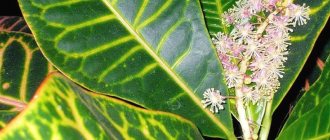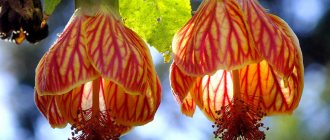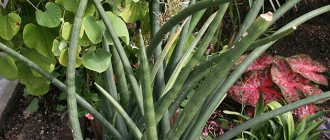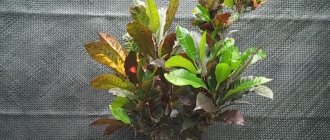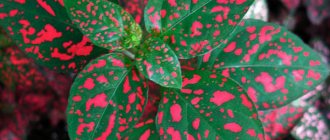Croton or codiaeum is one of the most popular decorative foliage indoor plants. The genus of culture includes 16 species of shrubs and trees of the Euphorbiaceae family.
In nature, representatives of the species grow in the tropical forests of Indonesia, Polynesia, Northern Australia, India and Malaysia.
Codiaum was brought to Europe at the beginning of the 19th century, where it was grown in greenhouses and greenhouses.
Croton bloom
Under natural conditions, trees can reach several meters in height, but indoor croton rarely grows to 1-1.5 meters. The main decoration of a tropical plant is its colorful foliage, which delights gardeners with a variety of shapes and colors.
Leathery, smooth and shiny leaves, depending on the variety and type, can be narrow, lobed, long, short, with smooth or wavy edges.
The foliage of most species has a clear, yellow pattern along the lines of the veins of the leaf blade.
The variegated color of the leaves forms an amazing combination of color shades: green, red, yellow, red, white, pink or brown.
Watering
Croton grows well in slightly moist soil without drying it out. Enough moist soil so that the roots are not literally standing in water. It is better to water a small amount of water in several portions regularly than to pour a large amount at once. By touching the ground with your finger, you can easily determine the humidity. If the soil seems dry, water it again. In cooler temperatures and less light (winter), Croton uses less water, so adjust the amount of water accordingly by watering less.
The amount of water depends, among other things, on temperature and light intensity. With a newly purchased plant or after moving, it is advisable to start with a small amount of water. If the soil is still very wet after 4 days, water less. If the soil becomes dry again after 2 days, water again. By regularly checking the soil for moisture by dipping your finger into it, you will automatically know how often and how much water the plant needs.
Water system
If you fill a houseplant with substrate and equip it with a water meter, the water dosage will change. Water once a week. Pay attention; The water drains slowly, so the water meter responds with a delay. In winter, water once every two weeks.
Spraying
Regular spraying of Croton is necessary to prevent the appearance of spider mites. The more often the better, but at least once a week. When the heater is on, it is recommended at least twice a week.
Taking a warm shower twice a year also provides benefits. To do this, cover the soil with cling film so as not to overwater it. The shower has a preventative effect against pests and removes dust from the leaves. This benefits the houseplant and makes it look more beautiful. A dust-free leaf receives more light, which gives the plant a richer color.
Reproduction technology
Croton propagates under indoor floriculture conditions through cuttings. Decorative crops can be propagated by cuttings almost all year round. For this purpose, it is best to cut off the apical cutting or woody stem cutting 10-12 cm long. The milky sap must be carefully removed from the cut under running water and treated with crushed charcoal and a growth stimulator, after which the cutting must be planted in the soil mixture.
For rooting, a nutrient substrate based on coarse sand with the addition of peat soil is optimal. Measures for caring for cuttings include periodic spraying of plants and moistening the soil. The temperature regime until the stage of complete rooting should be within 24 ° C. It is also allowed to root cuttings of an ornamental crop in water, after which the plant must be transplanted to a permanent place in a flower pot filled with nutritious soil. Crotons are propagated by leaves using the same principle.
Light and warmth
The miracle bush prefers to receive a lot of light. But be careful of direct sunlight during the summer months. Croton is grown in diffused light, avoiding drafts. If it is in front of a south-facing window, it is recommended to maintain a distance of 2 to 3 meters. Gradually the plant can be brought closer to the window.
Croton needs at least 5 hours of good light per day. Therefore, it is advisable to place these indoor plants directly in front of a window in the east, west or north. If there is insufficient light, fresh leaves will not appear and the plant may droop existing leaves. If predominantly dark leaves are present, the indoor plant can be placed a meter closer to the window.
Minimum temperature
| During the day: | 18 ℃ |
| 'At night, in the evening: | 12 ℃ |
Croton species
Croton laxative (Croton tiglium)
A small shrub or tree up to 12 m tall, evergreen. Leaves are alternate, membranous, ovate with a broadly rounded, sometimes slightly drooping base, pointed, acute or obtuse, very finely serrated, glabrous above, with several star-shaped hairs below, 7.5-17 cm long, 4-9.5 cm wide, from metallic green to bronze or orange. The petiole is thin, about 4 cm long; conditionally yellow, 1.5-3.5 mm long. The inflorescence axis is bare; the flowers are small and inconspicuous. Male flowers are star-shaped and hairy with narrowly elongated petals and 15-20 stamens; female flowers are apetalous; capsule with stellate hairs, triangular, 15-20 mm long, 10-15 mm wide, oblong or ellipsoid, 3-lobed. Seeds 3 per fruit, oblong-ovate, orange, about 12 mm long, smooth
Croton lechleri
It is a flowering plant with a broad but open crown, native to northwestern South America. It grows up to 20 meters in height with a trunk diameter of usually 30 cm. It is also known as Sangre de Drago. It is characterized by thick red latex, which has medicinal properties. It is used as a liquid dressing for wounds and other skin injuries and disorders. It is an effective antiviral treatment and is also used in the treatment of tumors.
Variegated Croton (Croton variegatum)
With its gorgeous foliage in rich fall colors, garden croton exudes living space comfort and good cheer. Fine varieties of this species with impressively decorative leaves also serve as a refreshing air freshener. It's no surprise that the tropical, evergreen ornamental plant is at the top of the list of most popular houseplants. The most
Transfer
Replant Croton in the spring or immediately after purchase. Repeat this when the pot becomes too small. This is possible after a year, but usually once every 2 years is sufficient. Replanting is preferable in the spring, since at this time damaged roots are restored faster. Place the houseplant in a pot that is at least 20% wider than the pot it is in, and use regular potting soil. Do not place hydropellets in the bottom if the pot is closed. Stagnant water that accumulates between the grains of the hydraulic system cannot be easily reached by the roots and rotting occurs.
A larger pot encourages growth, improves plant health, and creates a buffer for more water because the soil can absorb more moisture. The latter ultimately simplifies the maintenance of Croton.
Flowering - should it be allowed at home?
According to popular belief, the flowering of croton is considered a bad sign, but this is a superstition. If a flower blooms, then home care is suitable for it. Another thing is that you won’t be able to get seeds for seedlings from one plant, since you need male and female flowers.
In addition, flowering takes a large amount of nutrition and the flower weakens. If you do not take care of feeding in time, it may even die. In order not to risk a mature beautiful plant, the arrow that appears can be cut off and the cut treated with crushed coal.
Trimming
If Croton grows too tall, you can prune it by cutting down the trunk. It is better to do this in spring or summer so that the trunk sprouts again. It is advisable to prune the shoots before each fall so that in winter more light reaches the core of the indoor plant. In spring Croton sprouts again. When trimmed, it will emit a milky white color that can be stopped with coal chips or cigarette ash. Once cut, the trunk will be susceptible to bacterial infections. We recommend sealing the cut with wax or cigarette ash.
Caring for Codiaum Gold Sun.
Temperature. This species requires a warm climate. The best temperature for it varies from +21 to +25. It can withstand +1 8. at excessively cold temperatures, its roots can quickly die. It is especially important to keep Codiaum Gold Sun away from drafts.
Lighting. This type of plant is very sensitive to light, so it should be given as much light as possible.
Watering. Codiaemum Gold Sun really needs water in summer, so you should keep the soil in the pot moist, but not too wet. Excess water should be poured out immediately, as this contributes to the formation of dampness, and dampness contributes to suppuration of the roots. You need to water the plant with warm water.
Air humidity. Codiaeum variegatum Gold San requires tropical humidity. To create a comfortable environment, you can use a humidifier. It must be sprayed daily with warm water and the leaves wiped with a wet sponge. It is also recommended to water the leaves frequently in the shower.
Fertilizer. In summer, the plant grows rapidly. During this period, Kodiemum Gold Sun needs special care and requires feeding. For this, the best option would be liquid fertilizer Ideal and Oasis. Before giving it fertilizer, it is worth watering it thoroughly. In winter, Codiaum (Croton) variegated Gold Sun grows slowly, so it needs to be fed frequently.
The soil. Alkaline soil is suitable for Gold Sun croton. The soil mixture is prepared from peat, coarse sand and humus. Humus is used as a rich fertilizer.
Transfer. The plant can be replanted from store-bought substrate after cleaning the roots. When choosing a pot, you need to choose one that is not very wide. The bottom of the dish must be filled with drainage. The soil should be cleared of pests. Charcoal prevents root rot. The plant needs to be replanted often when it is still young.
Reproduction. Codiaeum variegatum Gold San propagates in spring through cuttings that are found at the top of the plant. The largest ones are selected and cut from the stem and then placed in water to cleanse the poisonous juice. When working, be sure to wear gloves. After drying the cuttings, the shoots should be planted in a pot with damp peat. Roots will begin to appear in a month.
Trimming. To give the plant a more beautiful shape, it needs to be trimmed. The tops of the cuttings can be trimmed to 16 cm. After trimming, it needs to be treated with charcoal so that the tree sap does not expire.
Diseases. This type of plant is rarely susceptible to disease. Its poisonous juice can kill any insect.
Types
Various species of Croton are known. Some varieties: Petra, Mammy, Sunny Star, Tamara, Curly Boy, Excellent and Red Banana.
Croton Petra
The most famous Croton is Petra, this species has the most brightly colored leaves. The great thing about this type of Croton is that the leaf vein is the same color as the leaf, just a brighter color. This gives a pleasant effect.
Croton Norma
Croton Norma has pointed leaves with a glossy surface with a slight depression in the middle. This is an exclusive variety.
Croton Miss Eyeston
The most accessible Croton is Miss Iceton. Unlike Peter, it has no noticeable veins on the leaves, it has a beautiful smooth soft leaf.
Croton Gold Dust
Dark green Croton, with golden yellow speckles. It comes in a variety of colors: yellow, red, copper, green, pink, ivory, orange and brown.
The brighter place you place this Croton, the more spots there will be on its leaves.
Croton Curly Boy
Croton Curly Boy gets its name from its curly leaves and deep red color. This Croton remains relatively dark even if you place it in a lighter location.
Croton Mammy
Croton Mummy - Similar to Curly Boy, but with slightly less curved leaves and more variety in color. The great thing about this Crotona is that it can come in very rich colors.
Croton Codeium Excellent
A dark variety with inconspicuous leaf veins. Croton Kodiema Excellenta has unique leaves, they say if you are very creative, you can see a parrot's head in them.
Botanical description of the plant
Croton (Latin name Codiaeum) is a perennial evergreen plant of the Euphorbiaceae family. In nature, it is found in tropical and subtropical forests of Australia, Oceania (Polynesia), India, as well as some islands of Southeast Asia (Malaysia, Philippines, etc.). Due to the amazing colors of the leaves, the flower is sometimes popularly called “Joseph’s Cloak.”
Did you know? Codiaum is the original name of the plant, probably coined by its discoverer, the Dutchman Georg Rumphius, who studied orchids on the island of Ambon in Indonesia in 1654 and saw the original shrub there. Local residents called the perennial with the beautiful word “kodibo”, although today “codiaum” is rather associated with the Greek “codeia”, which means “head”.
Despite the fact that the plant came to Europe in the second half of the 17th century, the real fashion for it began only three hundred years later. Together with Dieffenbachia and Dracaena, croton initially began to be grown by flower growers from the Netherlands, and from there it began to conquer the world.
When describing the botanical features of codiaum, it is necessary to highlight the following main characteristics of the plant:
| Maximum dimensions | 50–150 cm (in the wild - up to 300 cm) |
| Root system | Powerful, fast growing |
| Stems | Dense, erect, with a large number of lateral processes |
| Leaves | Petiolate. The structure is dense and leathery, with a beautiful gloss. The sizes are large (up to 30 cm in length). The shape can be different (lanceolate, three-fingered, oval, lobed, carved, spiral, often flat, but sometimes with wavy edges). A distinctive feature is a bright and bizarre color: against the main background of any shades of green, there may be stains, veins, stripes, inclusions and other fragments of yellow, white, purple, pink and other contrasting or nuanced colors |
| Inflorescence | Racemose (panicle) |
| Flowers | Small, undecorative, white, yellow or beige with long protruding anthers |
| Fruit | Box with large seeds inside |
Important! Like other Euphorbias, codiaum is poisonous. It is not advisable to keep such a flower for people who have pets (primarily cats). Also, croton juice can cause serious irritation on the skin, so pruning and replanting the plant should be done with protective gloves.
An interesting botanical feature of codiaum is the ability to change the color and shape of leaves depending on environmental conditions. It is on this amazing property that active breeding work aimed at developing new varieties of decorative flowers is based.

